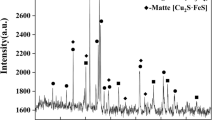Abstract
Bottom blown oxygen copper smelting process, operated at high grade matte (up to 75 wt% Cu) with relatively low (2–3 wt%) Cu in slag, has been commercialized for more than five years at Dongying Fangyuan Nonferrous Metals CO., Ltd. Quenched slag and matte samples have been collected at different operating conditions while the slag temperature was measured by thermocouple. The samples were analysed by X-ray Fluorescence and Electron Probe X-ray Microanalysis. FactSage computational software was used to explain the observations of the industrial samples. The analyses show that the copper loss was closely related to the operation parameters. The Fe/SiO2 in slag and temperature determine the solid proportion, which significantly affects the physical entrained and also chemically dissolved copper in the slag. The present study will be useful in understanding the slag chemistry of bottom blown copper smelting furnace and in optimization of the operating conditions to lower Cu loss in the slag.
Access this chapter
Tax calculation will be finalised at checkout
Purchases are for personal use only
Preview
Unable to display preview. Download preview PDF.
Similar content being viewed by others
References
B. Zhao, Z. Cui, and Z. Wang. “A New Copper Smelting Technology — Bottom Blown Oxygen Furnace Developed at Dongying Fangyuan Nonferrous Metals.” (4th International Symposium on High-Temperature Metallurgical Processing, San Antonio, US, 2013), 3–10.
C. Bale, E. Bélisle, P. Chartrand, S.A. Degterov, G. Eriksson, K. Hack, I.H. Jung, Y.B. Kang, J. Melançon, and A.D. Pelton. “FactSage Thermochemical Software and Databases — Recent Developments.” Calphad, 33(2), 2009: 295–311.
R. Roscoe. “The Viscosity of Suspensions of Rigid Spheres.” British Journal of Applied Physics, 3(8), 1952: 267–269.
I. Imris. “Thermodynamic Study of the Cu-Fe-S-O-SiO2 System.” PhD Thesis, University of Kosice, 1971.
A. Yazawa and M. Kameda. “Fundamental Studies on Copper Smelting (II) Solubilitiesof Constituents of Matte in Slag.” Technical Reports Tohoku University, 19, 1954: 1–22.
A. Geveci and T. Rosenqvist. “Equilibrium Relations between Liquid Copper, Iron–Copper Matte and Iron Silicate Slag at 1250°C.” Trans. Inst. Min. Metall (Mineral Process. Extract. Metall. C), 82, 1973: C193–C201.
M. Nagamori. “Metal Loss to Slag: Part. I. Sulfidic and Oxidic dissolution of copper in fayalite slag from low grade matte.” Metall. Trans., 5, 1974: 531–538.
F.J. Tavera and W.G. Davenport. “Equilibrations of Copper Mattes and Fayalite Slag under Controlled Partial Pressures of SO2.” Metall. Trans. B, 10B, 1979: 237–241.
K.H. Jalkanen. “Copper and Sulphur Solubilities in Silica Saturated Iron Silicate Slags from Copper Mattes.” Scand. J. Metals, 10, 1981: 177–184.
P.J. Mackey. “The Physical Chemistry of Copper Smelting Slags — A Review”, Can. Metall. Q., 21, 1982: 221–260.
A. Yazawa, S. Nakazawa, and Y. Takeda. “Distribution Behaviour of Various Elements in Copper Smelting Systems” (Advances in sulfide smelting, TSM-AIME, Warrendale, PA, US, 1983) 99–117.
R. Shimpo, S. Goto, O. Ogawa, and I. Asakura. “A Study on Equilibrium between Copper Matte and Slag.” Can. Metall. Q., 25, 1986, 113–121.
R. Sridhar, J.M. Toguri, and S. Simeonov. “Copper Losses and Thermodynamic Considerations in Copper Smelting.” Metall. Mater. Trans. B, 28B, 1997: 191–200.
I. Imris, M. Sanchez, and G. Achurra. “Copper Losses to Slags Obtained from the EI Teniente Process.” Mineral Process. Extract. Metall. C (Trans. Inst. Min. Metall.), 114, 2005: C135–C140
Author information
Authors and Affiliations
Editor information
Editors and Affiliations
Rights and permissions
Copyright information
© 2015 TMS (The Minerals, Metals & Materials Society)
About this chapter
Cite this chapter
Chen, M., Cui, Z., Zhao, B. (2015). Slag Chemistry of Bottom Blown Copper Smelting Furnace at Dongying Fangyuan. In: Jiang, T., et al. 6th International Symposium on High-Temperature Metallurgical Processing. Springer, Cham. https://doi.org/10.1007/978-3-319-48217-0_33
Download citation
DOI: https://doi.org/10.1007/978-3-319-48217-0_33
Publisher Name: Springer, Cham
Print ISBN: 978-3-319-48603-1
Online ISBN: 978-3-319-48217-0
eBook Packages: Chemistry and Materials ScienceChemistry and Material Science (R0)




